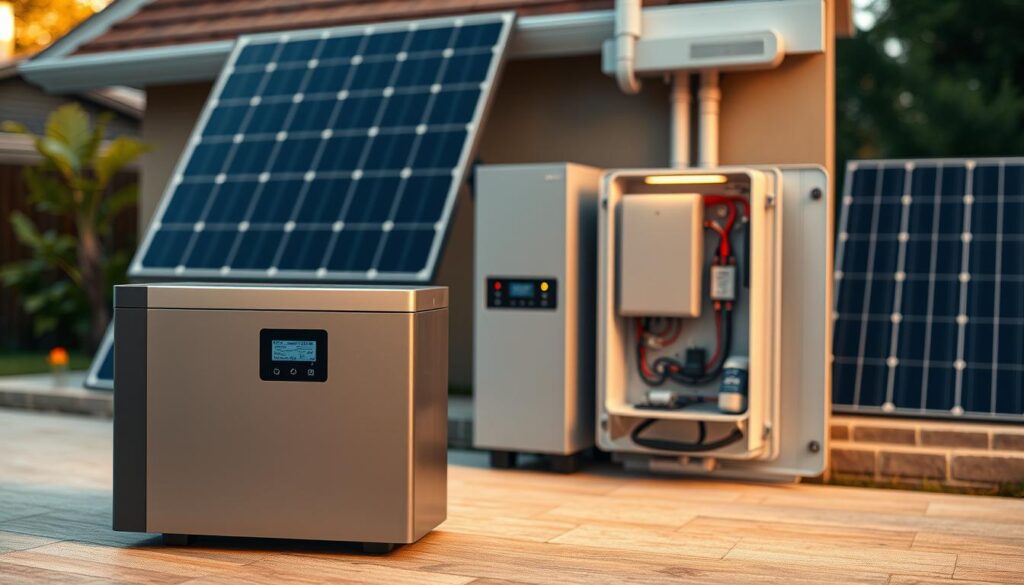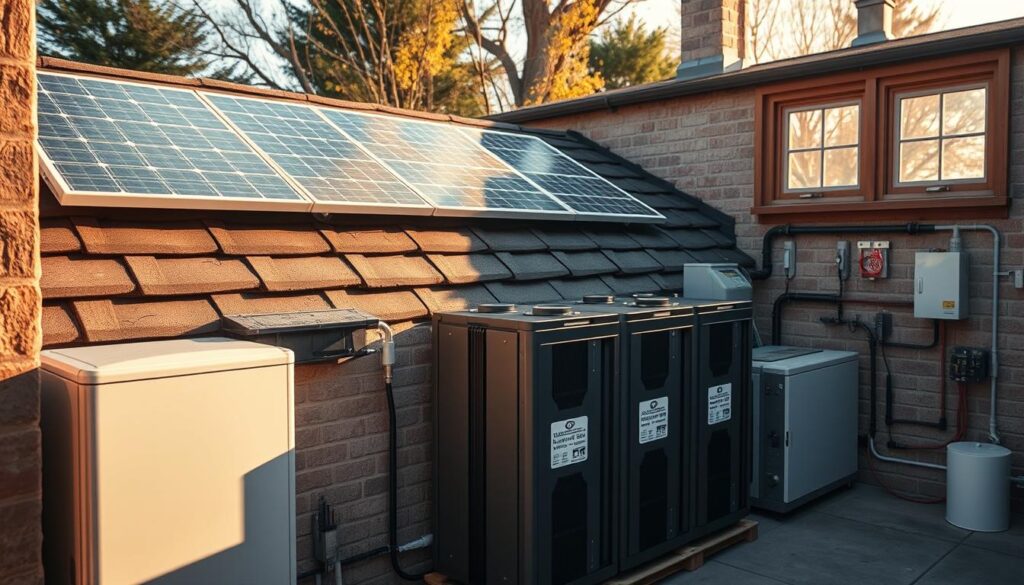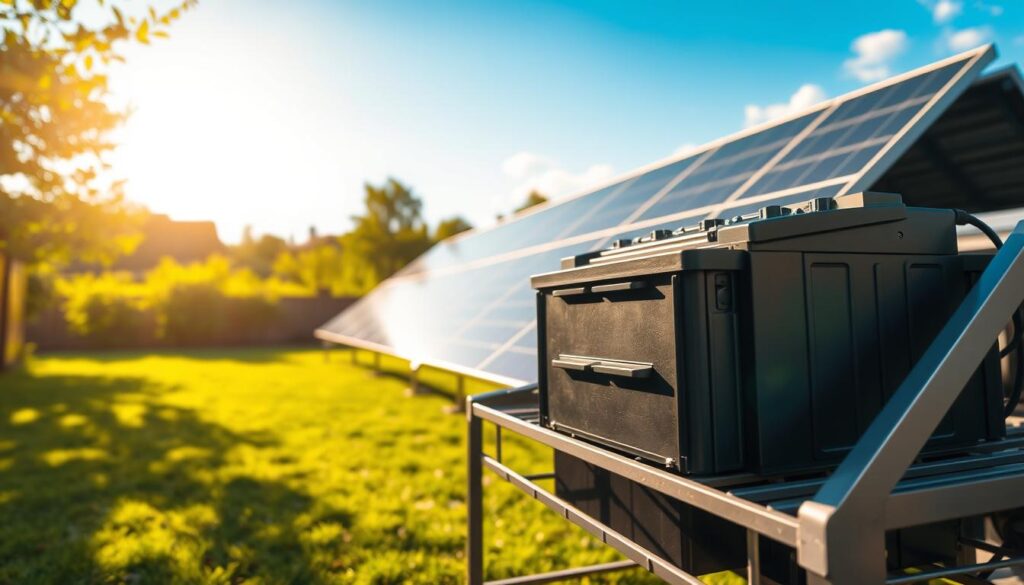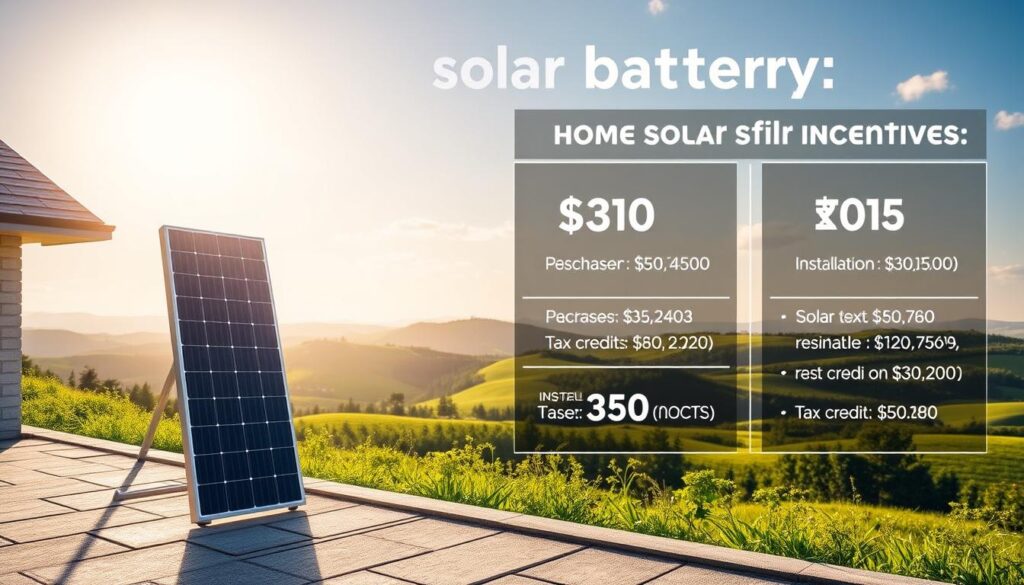Harnessing the sun’s energy has never been easier or more efficient. With advancements in technology, solar panels paired with modern energy storage systems are transforming how we power our lives. These systems store excess electricity generated during the day, allowing you to use it at night or during outages.
Leading models like the Bluetti EP900 and Tesla Powerwall are designed to be modular and scalable, fitting seamlessly into your lifestyle. Not only do they reduce reliance on the grid, but they also help lower electricity bills. Plus, they provide peace of mind by ensuring backup power when you need it most.
This guide will walk you through everything you need to know about choosing the right solar battery solution. From understanding capacity to evaluating cycle life, we’ll help you make an informed decision that aligns with your energy needs and budget.
Key Takeaways
- Modern systems store excess energy for use during outages or at night.
- Top models like the Bluetti EP900 and Tesla Powerwall are scalable and efficient.
- These systems can significantly reduce electricity bills.
- They provide reliable backup power during grid failures.
- Choosing the right system depends on capacity, cycle life, and budget.
Understanding Home Solar Batteries
Modern energy solutions are reshaping how we manage power in our daily lives. A residential energy storage system plays a crucial role in maximizing the efficiency of renewable energy sources. These systems store surplus electricity generated during peak production hours, ensuring it’s available when needed most.
When your panels produce more energy than you use, the excess is saved in the storage unit. This stored power can be used during nighttime or cloudy days when production drops. It’s a smart way to maintain a consistent energy supply and reduce reliance on the grid.
One of the standout benefits is backup power during outages. With a reliable system, you’ll never be left in the dark. Additionally, storing energy allows you to take advantage of time-of-use savings, reducing your monthly utility bills significantly.
By understanding these fundamentals, you’re better equipped to explore advanced features and technologies in later sections. Whether it’s for cost savings or energy independence, these systems offer a practical solution for modern living.
How Do Solar Batteries Work?
Understanding the mechanics of energy storage can unlock its full potential. These systems are designed to capture and store excess electricity generated during peak production hours. This stored power can then be used when production drops, ensuring a consistent energy supply.

Energy Storage & Conversion Basics
At the core of these systems is the ability to convert and store excess electricity. When your panels produce more energy than you use, the surplus is saved in the battery storage unit. This process ensures that you have a reliable source of power during outages or at night.
Lithium-ion batteries are the most popular choice due to their high capacity and efficiency. They can store up to 95% of their total capacity, making them a practical solution for modern living. This technology allows you to maximize the use of renewable energy and reduce reliance on the grid.
AC vs. DC Coupling Explained
There are two main types of systems: AC-coupled and DC-coupled. DC-coupled systems are more efficient because they require only one conversion from DC to AC. This reduces energy loss and improves overall system performance.
On the other hand, AC-coupled systems involve three conversions, which can lead to efficiency losses. However, they are often easier to integrate into existing setups. Choosing the right system depends on your specific needs and setup.
Here’s a quick comparison:
- DC-coupled: Higher efficiency, fewer conversions, ideal for new installations.
- AC-coupled: Easier integration, better for retrofitting existing systems.
By understanding these differences, you can make an informed decision that aligns with your energy goals.
Top Solar Battery Options for 2025
The future of energy storage is here, with top-tier options leading the way in 2025. These systems combine cutting-edge technology with practical features to meet modern energy needs. Whether you’re looking for high performance, modular designs, or robust customer support, there’s a solution for you.
Highlights of Bluetti EP900
The Bluetti EP900 stands out for its modular design and exceptional performance. Experts praise its ability to scale according to your needs, making it a versatile choice. With a high round-trip efficiency and a 10-year warranty, it’s a reliable option for those seeking long-term value.
Tesla Powerwall 3 and Enphase IQ Battery
The Tesla Powerwall 3 offers impressive power output at 11.5 kW, ideal for larger setups. Its sleek design and seamless integration with existing systems make it a popular choice. On the other hand, the Enphase IQ Battery shines with its robust customer support and user-friendly interface, ensuring a hassle-free experience.
When comparing these models, cost and features play a significant role. Here’s a detailed breakdown to help you decide:
| Model | Output Power | Warranty | Price |
|---|---|---|---|
| Bluetti EP900 | 9.6 kW | 10 years | $12,000 |
| Tesla Powerwall 3 | 11.5 kW | 10 years | $13,500 |
| Enphase IQ Battery | 5 kW | 10 years | $10,000 |
Each option has its strengths, so consider your specific needs and budget. Whether it’s the Bluetti EP900’s modularity, the Tesla Powerwall 3’s power, or the Enphase IQ Battery’s support, you’re sure to find a system that fits your lifestyle.
Pros and Cons of Solar Battery Systems
Modern advancements in energy storage offer both benefits and challenges. These systems provide a reliable way to manage power needs, but they also come with certain limitations. Understanding the trade-offs can help you make an informed decision.

Key Benefits
Energy storage systems bring several advantages to the table. Here are the top benefits:
- Backup Power: During a power outage, these systems ensure your lights stay on and essential appliances keep running.
- Reduced Utility Bills: By storing excess energy, you can reduce reliance on the grid and lower monthly utility costs.
- Energy Independence: Generate and store your own power, reducing dependence on external energy providers.
- Environmental Impact: Using stored energy reduces your carbon footprint, contributing to a greener planet.
Potential Drawbacks
While the benefits are significant, there are some challenges to consider:
- High Upfront Costs: The initial investment can be steep, with prices ranging from $12,000 to $22,000.
- Limited Capacity: A single unit may not provide enough amount of energy for whole-home coverage, requiring multiple units.
- Performance Variability: Factors like battery lifespan and depth of discharge can impact overall efficiency.
- Maintenance Needs: While minimal, occasional inspections or part replacements may be necessary.
Investing in energy storage is a big decision. Weighing the pros and cons can help you determine if it’s the right choice for your needs. Whether it’s for backup power during outages or reducing utility bills, these systems offer a practical solution for modern energy challenges.
Choosing the Best Solar Battery for Your Home
Selecting the right energy storage solution starts with understanding your unique needs. Whether you’re looking for backup power during outages or aiming to reduce utility bills, matching your system to your energy usage is crucial. Here’s how to make the best choice for your setup.
Evaluating Your Home’s Energy Needs
Start by assessing your energy need. Review your monthly utility bills to understand your average consumption. This helps determine the storage capacity required to meet your goals. For example, if you use 30 kWh daily, a system with at least 10 kWh capacity ensures reliable backup.
Consider your usage patterns. Do you need power during peak hours or extended outages? Systems with modular designs allow you to scale up as your needs grow, ensuring long-term flexibility.
Warranty, Budget, and Feature Comparison
Warranties are a key factor. Most systems offer 10-year warranties, but some extend up to 15 years. A longer warranty often indicates better durability and performance. Compare this with your budget to find a balance between cost and reliability.
Features like smart monitoring and modularity add value. Smart systems let you track energy usage in real time, while modular designs allow easy upgrades. These features enhance convenience and future-proof your investment.
Consulting local installers can provide tailored solutions. They assess your setup, recommend the best options, and ensure proper installation. This step ensures your system meets your specific energy need and performs optimally.
By evaluating your usage, comparing warranties, and exploring features, you can choose a system that aligns with your goals. Whether it’s for backup power or cost savings, the right solution ensures long-term efficiency and peace of mind.
Solar Battery Installation: Process and Considerations
Installing an energy storage system involves careful planning and expert execution. From initial consultation to final testing, each step ensures your system operates efficiently and safely. Understanding the process helps you prepare for what’s ahead and ensures a smooth experience.

Installation Steps and Common Upgrades
The process begins with a consultation to assess your house’s energy needs. A professional installer evaluates your setup, including roof orientation and available space. This step ensures the system is tailored to your specific requirements.
Next, permits are obtained to comply with local building codes. This step varies by location but is essential for safety and legality. Once permits are secured, the hands-on installation begins, including wiring and connecting the system to your existing setup.
Common upgrades, like sub-loads panels, may be required to support backup circuits. These panels ensure your appliances receive power during outages. While these upgrades add to the initial cost, they enhance system performance and reliability.
Role of Local Companies and Installers
Local companyies and installers play a crucial role in the process. They provide customized solutions, ensuring your system meets your energy goals. Their expertise ensures proper integration with your existing setup, minimizing potential issues.
Professional installers also handle safety and technical considerations. Proper grounding and circuit protection prevent electrical hazards. They ensure the system complies with local codes, giving you peace of mind.
Real-World Examples and Tips
Real-world examples highlight common challenges and solutions. For instance, older systems may require upgrades to ensure compatibility. Working with a trusted company ensures these issues are addressed early in the process.
Here are some tips for smoother integration:
- Schedule a thorough site assessment before installation.
- Choose a system compatible with your existing setup.
- Ensure proper grounding and circuit protection.
- Work with experienced installers for seamless integration.
By following these steps and considerations, you can ensure a successful installation that meets your energy needs. Whether it’s for backup power or reducing utility bills, a well-installed system offers long-term benefits.
Comparing Costs and Incentives for Solar Batteries
Investing in energy storage is a significant decision, but understanding the costs and incentives can make it easier. The typical price range for installations falls between $12,000 and $20,000, depending on factors like system size and complexity. Installation fees can vary, with additional upgrades like sub-loads panels adding $1,000 to $2,000 to the total cost.

Price Range and Installation Fees
The overall cost depends on several factors. Larger setups or complex installations may require higher upfront investments. For example, lithium-ion systems, known for their high performance, often come with a higher price tag but offer better long-term value. Labor costs also play a role, especially if the system is added to an existing setup.
Determining the number of units needed is crucial. Most households require one to two units to cover energy needs during outages. Consulting with local installers can help tailor the system to your specific requirements, ensuring optimal performance and cost-effectiveness.
Federal Tax Credit and Local Rebates
One of the most significant incentives is the federal tax credit, which covers 30% of installation costs. For a $15,000 system, this translates to a $4,500 savings. Additionally, many local utility companies offer rebates, further reducing the upfront investment.
Here’s a breakdown of costs before and after applying the federal tax credit:
- 5 kWh: $6,500 → $5,000
- 13.5 kWh: $17,550 → $13,500
- 20 kWh: $26,000 → $20,000
Researching local incentives and comparing quotes from installers can help you maximize savings. With the right planning, energy storage can be a cost-effective solution for modern living.
Advanced Features and Technologies in Solar Storage
Innovations in energy storage are transforming how we manage power efficiently. Modern systems now come equipped with advanced features that enhance performance, reliability, and ease of use. From modular designs to intelligent monitoring, these technologies are setting new standards for energy management.
Modularity and Smart Monitoring
One of the standout advancements is modularity. Modular systems allow users to scale their storage capacity as needed. This flexibility makes it easier to upgrade without replacing the entire setup. It also enables precise maintenance, as individual modules can be serviced or replaced independently.
Smart monitoring systems are another game-changer. These tools provide real-time data on energy usage and system performance. By tracking individual module performance, users can identify issues early and optimize their storage efficiency. This level of control ensures the system operates at its best, extending its lifespan.
Why Lithium-Ion Batteries Lead the Way
When it comes to type battery options, lithium-ion stands out. Known for their high efficiency and durability, these batteries are the preferred choice for modern storage systems. They offer a longer lifespan and can handle more charge cycles compared to other chemistries.
Here’s a quick comparison of popular battery types:
- Lithium-ion: High efficiency, long lifespan, and lightweight.
- Lead-acid: Lower cost but shorter lifespan and heavier.
- Nickel-based: Good performance but less common and more expensive.
These innovations in modularity, monitoring, and battery chemistry contribute to better overall storage management. They ensure systems are reliable, efficient, and adaptable to future needs. With these advancements, energy storage is becoming smarter and more accessible than ever.
Energy Storage Capacity and Performance Metrics
Performance metrics are key to selecting the right energy solution. Understanding these factors ensures your system meets your needs efficiently. From capacity to round-trip efficiency, each metric plays a vital role in optimizing performance.
Understanding Capacity and Depth of Discharge
Energy storage capacity, measured in kilowatt-hours (kWh), determines how much power a system can store. For example, a 10 kWh system can provide 10 kW of power for one hour. This metric is crucial for sizing your system to match your energy needs.
Depth of discharge (DoD) indicates how much of the stored energy can be used without harming the system. A higher DoD, like 80%, means more usable energy. However, frequent deep discharges can reduce the system’s lifespan. Balancing DoD with cycle life ensures long-term reliability.
Power Output and Round-Trip Efficiency
Power output, measured in kilowatts (kW), defines how much energy a system can deliver at once. Systems with higher output ratings can handle peak demands, such as running multiple appliances during an outage.
Round-trip efficiency (RTE) measures how much energy is retained after storage and release. For instance, an RTE of 90% means only 10% of the energy is lost. Higher RTE systems are more cost-effective, as they maximize usable energy.
Here’s a comparison of popular systems based on these metrics:
| System | Capacity (kWh) | DoD (%) | Power Output (kW) | RTE (%) |
|---|---|---|---|---|
| Simpliphi PHI 3.5 | 3.5 | 80 | 3.5 | 95 |
| LG Chem RESU 10H | 9.8 | 90 | 9.8 | 92 |
| GS Battery SLX250-12 | 3 | 80 | 3 | 85 |
Real-world examples highlight the importance of these metrics. During a grid outage, a system with high capacity and power output ensures uninterrupted power. Similarly, solar energy systems with high RTE maximize energy savings.
By understanding these metrics, you can choose a system that meets your needs. Whether it’s for backup power or reducing reliance on the grid, these factors ensure optimal performance and long-term value.
Home Solar Battery Buyer’s Guide for the United States
Choosing the right energy storage solution in the U.S. requires careful consideration of local policies and energy needs. With rising electricity bills and increasing demand for reliable power, a lithium-ion battery is often the best choice. These systems offer high storage capacity and long-term value, making them ideal for modern households.
Start by evaluating your storage capacity needs. A typical U.S. household uses around 30 kWh daily, so a system with at least 10 kWh ensures reliable backup. Consider your local utility policies and grid reliability. Some areas offer incentives for using lithium-ion systems, which can significantly reduce costs.
Understanding your electricity bill is crucial. Look for time-of-use rates and peak demand charges. Storing energy during off-peak hours and using it during peak times can save you money.
“A well-designed system can reduce your monthly bill by up to 30%,”
says a leading energy expert.
Here’s a quick checklist to guide your decision:
- Assess your storage capacity needs based on daily usage.
- Check local incentives for lithium-ion systems.
- Review your electricity bill to identify potential savings.
- Compare warranties and performance metrics.
By following these steps, you can choose a system that meets your energy goals. Whether it’s for backup power or reducing your electricity bill, a lithium-ion battery offers a practical and efficient solution for U.S. homeowners.
Conclusion
As the energy landscape evolves, staying informed is key to making smart choices. Investing in energy storage offers significant benefits, from reducing utility bills to providing backup power during outages. Advancements in technology, like modular designs and smart monitoring, have made these systems more efficient and user-friendly.
When considering your options, evaluate cost factors and available incentives. Programs like the federal tax credit can make the transition more affordable. Consulting with a reputable company or installer, especially those with expertise in Enphase systems, ensures a seamless experience.
As you plan for the future, keep an eye on market trends and your long-term energy needs. With the right system, you can enjoy reliable power and contribute to a greener planet. Now is the perfect time to take the next step toward energy independence.
